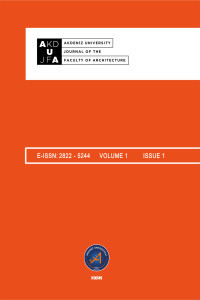PHILIP C. JOHNSON’IN MİMARİ TASARIMLARI ÜZERİNE “MODERN” VE “POSTMODERN” SÜREKLİLİĞİ AÇISINDAN BİR YORUM
Philip Cortelyou Johnson, Modern ve Postmodern mimari dönemleri içerisinde, küratör, felsefeci, tarihçi ve mimar kimlikleri ile farklı rollerde öne çıkmaktadır. Johnson bu dönemler içerisinde mimarlık sahnesinin en yeni mimari akım ve düşüncelerini ilk benimseyenlerden biri olmuştur. Modern mimarlığın savunucusu konumunda “İnsan ve çevre için tutarlı ve anlamlı katkılar üreten” bir mimar olarak tanınırken, ilerleyen süreç içerisinde “aykırı” kişiliği nedeniyle dönem içerisinde kalıplaşmış fikirlerin dışına çıkmaya çalışmıştır. Bu yönü Johnson’ın “Her mevsimin adamı” olarak anılmasına neden olmuştur. Bu çalışmada Johnson’ın söz konusu dönemler içerisinde farklı anlayışlarla ortaya koyduğu mimari tasarımları karşılaştırmalı olarak değerlendirilmiştir. Philip Johnson mimari dönemler içerisinde gelişen yeniliklere her daim açık olmuş ve bu aşamada mimari tasarımlarını “yenilik için yenilik” çerçevesinde gerçekleştirmiştir. Bu doğrultuda net ve radikal bir anlayışa sahip olamayan Philip Johnson’ın mimari anlayışının ve gücünün tartışılması ve Modern – Postmodern sürekliliği açısından yorumlanması hedeflenmiştir.
Anahtar Kelimeler:
Modern, Postmodern, Mimarlık, Pop Sanat, Philip Johnson, Uluslararası üslup
An Interpretation of Philip C. Johnson’s Architectural Designs with respect to the Continuity between “Modern” and “Postmodern”
Philip Cortelyou Johnson stands out in different roles during the modern and postmodern architectural periods with his identities as curator, philosopher, historian and architect. During these periods, Johnson was one of the first to adopt the latest architectural movements and ideas of the architectural scene. While he was recognized as an architect who “produced consistent and meaningful contributions for people and the environment” as an advocate of modern architecture, he tried to get out of stereotypes during the period due to his “contrary” personality in the following period. This aspect led to Johnson being referred to as “Man of all seasons”. In this study, the architectural designs of Johnson, which he put forward with different understandings during the mentioned periods, were evaluated comparatively. Philip Johnson has always been open to innovations that develop during architectural periods and at this stage he has carried out his architectural designs within the framework of “innovation for innovation”. In this respect, it is aimed to discuss the architectural understanding and power of Philip Johnson, who does not have a clear and radical understanding, and to interpret it in terms of modern - postmodern continuity.
Keywords:
Modern, Postmodern, Architecture, Pop Art, Philip Johnson, International Style,
___
- Carder, J.N., 2019. Philip Johnson and the Art Museum. Dumbarton Oaks Art, Nature, Scholarship. https://www.doaks.org/resources/philip-johnson/the-munson-williams-proctor-museum-of-art (Erişim Tarihi, 27.12.2019).
- Davidson, J., 2017. The AT&T Building faces yet another questionable makeover. New York Media.
- Filler, M., 1994. Prince of the City. New York Review of Books, Vol. XLII (9): 46-51.
- Hauptman, J., 1996. Philip Johnson: MoMa’s Form Giver, MoMa, (22): 20-24.
- Hesse, M., 2000, Moderne und Klassik. Kunstzitat und Kunstbewußtsein bei Philip Johnson. Zeitschrift für Kunstgeschichte, (63): 372-386.
- Islakoğlu, P. M., Tümer, G., 2005. Mimarlıkta Minimalizm. Ege Mimarlık Dergisi, Vol. 3 (55): 17-19.
- Johnson, P., 1961. Philip Johnson. Sheldon Art Gallery, Vol. 7: 3-8.
- Kuban, D., 2018. Mimarlık Kavramları-Tarihsel Perspektif İçinde Mimarlığın Kuramsal Sözlüğüne Giriş, YEM Yayınları, p. 114.
- Langdon, D., 2019. AD Classics: AT&T Building/Philip Johnson and John Brugee. https://www.archdaily.com/611169/ad-classics-at-and-t-building-philip-johnson-and-john-brgee (Erişim Tarihi, 25.12.2019).
- Lewis, H., O’connor, J., 1994. Philip Johnson The Architect in His Own Words. Rizzoli International Publication, p. 208.
- Matthews, H., 1994. The Promotion of Modern Architecture by The Museum of Modern Art in The 1930’s. Journal of Design History, Vol. 7 (1): 43-59.
- Pascucci, D., 2014. AD Classics: Munson-Williams-Proctor Arts Institute / Philip Johnson. https://www.archdaily.com/492133/ad-classics-munson-williams-proctor-arts-institute-philip-johnson (Erişim Tarihi, 25.12.2019).
- Schulz, F., 2005. Philip Johnson (1906-2005). Jounal of The Society of Architectural Historians, (4): 587-590.
- Sheldon, 2019. Sheldon Museum or Art https://sheldonartmuseum.org/renting-sheldon-museum-of-art (Erişim Tarihi, 23.12.2019).
- Stoller, E., 1961. Philip Johnson, Amon Carter Museum of Western Art, Forth Worth, Texas https://www.sfmoma.org/artwork/2004.70/ (Erişim Tarihi, 23.12.2019).
- Tigerman, S., 1996. Philip Johnson at 90: Some Problems of Autonomy in the 20th Century. Architecture of New York, (90): 48-49.
- Wagner, K., 2019. Philip Johnson and The Birth of Corporate Starchitecture. The Nation.
- Wikiland, 1019. “A Glass House”. https://www.wikiwand.com/pt/Philip_Johnson (Erişim Tarihi, 21.12.2019).
- Yayın Aralığı: Yılda 2 Sayı
- Başlangıç: 2022
- Yayıncı: Akdeniz Üniversitesi
